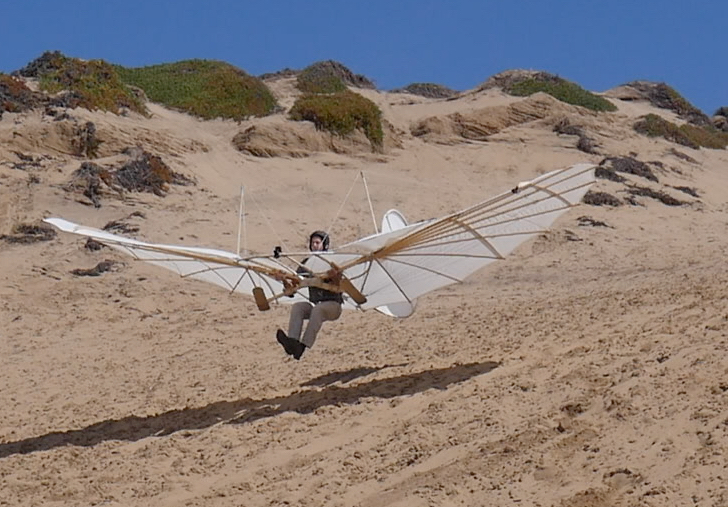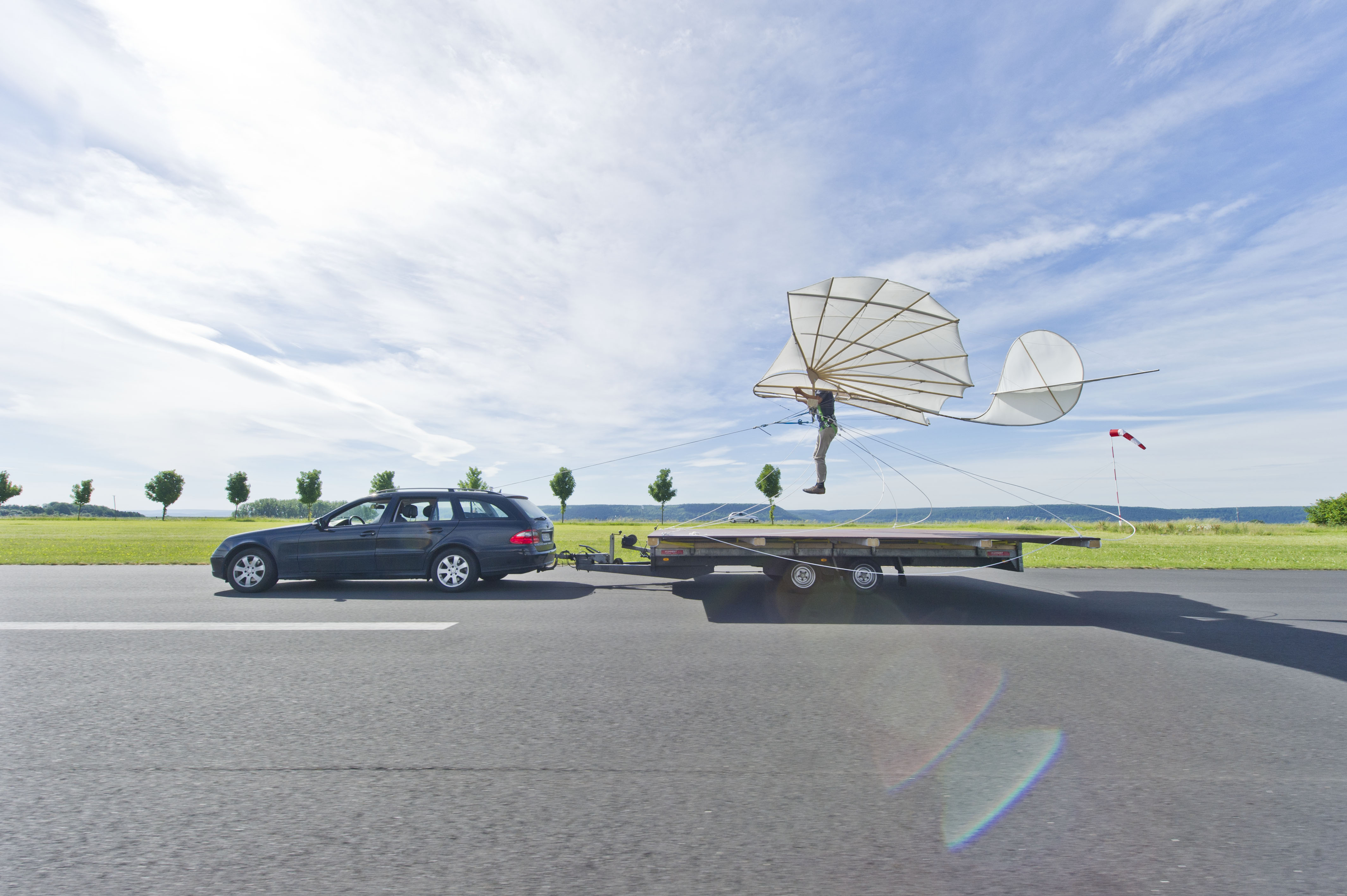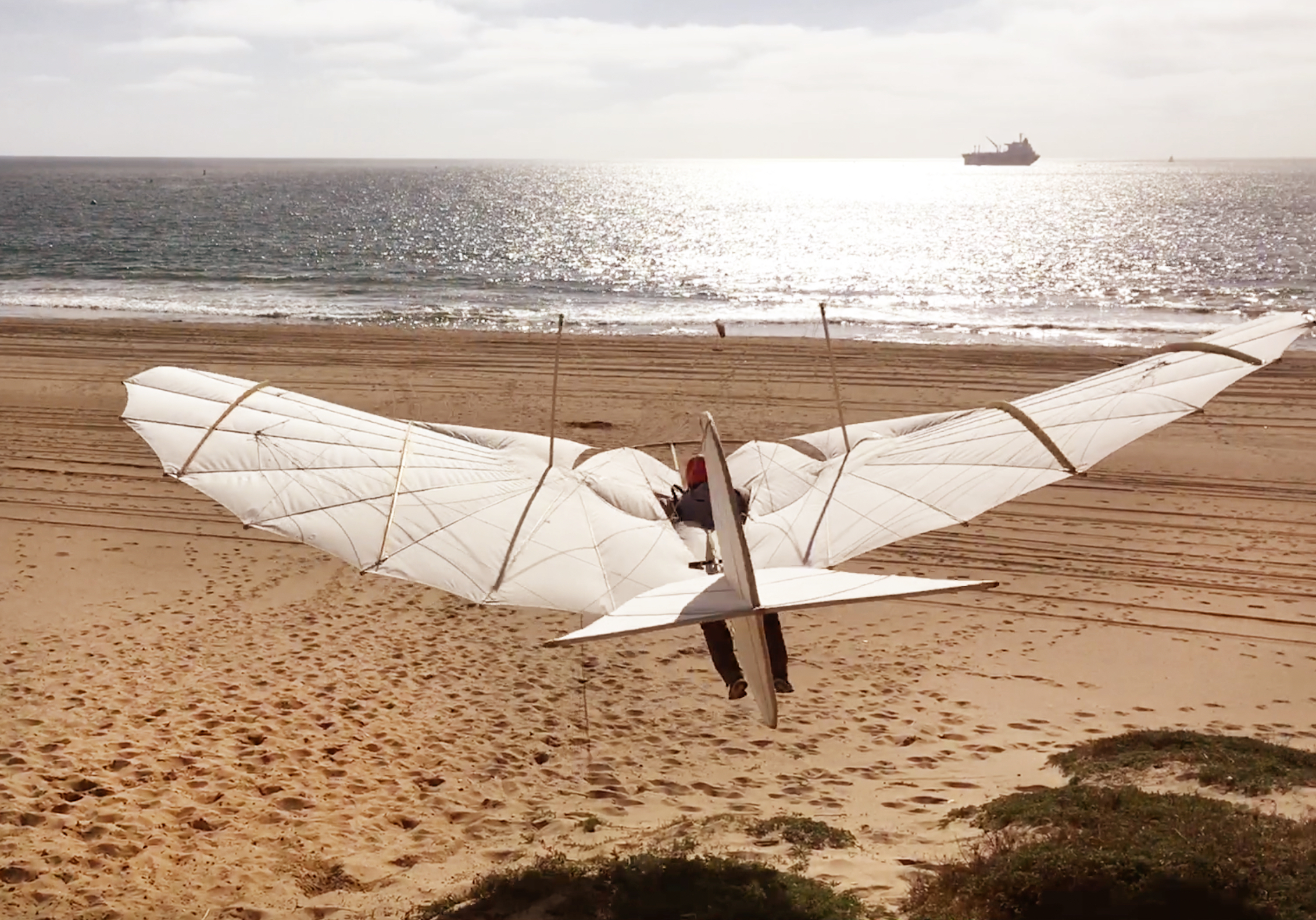By Markus Raffel
Originally published in USHPA Pilot, December 2018
When I stood on the sand dune in northern California in April of this year, with the wind interacting with the 32-kilogram wings of my self-made replica of Otto Lilienthal’s glider, I started hesitating. I was approximately 25 meters above the beach—nothing that could scare a seasoned pilot of a modern hang glider. But being those 25 meters in a willow skeleton covered with a thin white bed sheet that had been designed 125 years ago, gave me pause.

I remembered what had happened when I was caught by a gust some weeks earlier. It lifted me four meters in just one second, and for a short time, this upwards acceleration nearly doubled the force acting on my legs, leaving me confused as to how I should react. My instinct told me to stretch my legs to try to reach the ground. But the glider pitched up, and I stopped in the air and fell relatively softly, with the glider acting as a kind of parachute. The patented pivoted tail plane had worked as it was intended to. Lilienthal’s dihedral wing design did the rest, and the glider and pilot fell nicely in horizontal orientation.
I was hanging in it vertically, landing first on my feet, then on my knees. But even if the fall happened in a kind of slow motion, having 32 kilograms of weight attached to my shoulders makes me remember the landing. So I learned the hard way what my flight instructors told me: The most important lesson to remember is to know when not to fly.
I have been working in experimental aerodynamics for more than 25 years. This doesn’t make me an expert in the physics of flight, but it has made me interested in various aspects of it.
I flew powered small aircrafts in Europe and the US with passion, but became really obsessed by the idea of flying Otto Lilienthal’s wonderfully designed monoplane after the successful wind tunnel tests done by the German Aerospace Research Establishment (DLR). These tests, as well as the center-of-gravity tests, performed by an athletic young DLR employee, proved the potential st ability of Otto Lilienthal’s foldable mono-plane, his “Normalsegelapparat”, for the first time scientifically. However, this meant the glider flies in steady condition, with an operator capable of holding his legs horizontally forward, while holding himself in the glider with only his hands and his arms. But, does that mean an inexperienced pilot of average fitness can foot-launch it, fly it safely, and perform coordinated flare landings?
In April of last year I took a vacation and learned to safely fly a hang glider downhill in Millau, France. I started building my Lilienthal glider after the original patent drawings supported by my PhD student Felix Wienke, Markus Krebs, and other flight enthusiasts. In doing so, we basically copied the DLR’s glider that was made under the advice of Bernd Lukasch, the director of the Otto Lilienthal Museum in Anklam (Germany).
We used the same fabric that was used by the museum, which was shirting woven on an authentic machine, based on the instructions found during a careful analysis of the original material. The rest of the glider consists of a pinewood mainframe, willow cockpit, and tail and steel wires located between the main frame and the wings, like the original. For the struts that form the wings we used pine wood (bent into shape while wet) instead of willow, because of my heavier weight and the fact that the aerodynamic loads during the planned towing tests were going to occur higher than during free downhill flights.
After successfully testing the glider with more than 100kg sand ballast, we started tethered flights on a 5m x 5m platform. The glider and I were attached to a trailer that was towed by my car. This allowed me to gain some experience with the glider without risk. I could easily learn how to counteract an unwanted roll to one side by swinging my legs to the opposite one. I could also control the altitude by leaning forward and backward in the glider. However, this pitch control was limited, due to the way we attached the towing rope on the glider. And a pitch-up input on the trailer did not result in deceleration, because Markus used the cruise control, and my car didn’t bother too much about the additional drag. That was another big difference to free flight.

During the second step, I performed flights at a limited altitude of an average of two meters attached to a rope winch, which we built with a modified Italian scooter that had a reel instead of the rear wheel. With this scooter, Felix powered and controlled my flights over and up to 200m distance. I flew at speeds of up to 50km/h over soft grass. Due to our self-imposed altitude limit, we couldn’t detach the rope and had to maintain the tension until shortly before landing.
Otto Lilienthal built a training hill 15 meters high just for his flight testing. The cone-shaped hill allowed him to always start facing into the wind. It was surrounded by flat fields and, up to moderate wind speeds, there were likely only moderate gusts. I tried for a long time to find something similar close to where I live, but couldn’t replicate such ideal conditions. The winch allowed me to train on a small airfield, where we also placed the leading rope block in a manner that allowed me to start against the main wind direction. During these winch flights, in contrast to the tethered flights, I had to be able to control the roll angle and, therefore, also yaw reliably. The pitch trim during most of the flight, however, was still obtained by the variation of the attachment location of the rope. Only during the last meters, when the tension of the towing rope ended, a big difference was made if I had remembered early enough to lean back, by either stretching my arms or not. Moving my chest just a few centimeters away from the crossbars that form the mainframe of the glider caused it to flare and land softly. When I forgot that or didn’t coordinate well with Felix, I was reminded of the benefits of kneepads and the convenience of soft grass below me.
The controllability of Lilienthal’s monoplane was finally proven during free downhill flights in California. The most successful free flights were performed at a sand dune with adequate slope and height supported by a gentle and constant wind at the beach close to Monterey. The trim, especially the pitch trim, was the most elaborate part of the flight, because it was influenced by the flexibility of the wooden structure, the tension of the wires below the wing, and the weight, height and fitness of the pilot.
I was 12 years older than Lilienthal when he started to fly, 12 kg heavier and 12 cm taller than he (55, 90 and 192 respectively). So I had to run faster, move more weight, and create more drag. (I also wasn’t as fit as Herr Lilienthal.) He, on the other hand, frequently jumped from the roof of a building and managed to come to a stable fast downhill flight afterward. The famous photographs of Lilienthal with his legs high up in the air—frequently towards one side—were later used to explain how imperfect his method of control was. However, he knew very well what he was doing and decided, after testing flaps, wing warping, and an actively pivoted tail plane, to willingly control his wings by weight shifting, just as many thousands of pilots do while flying weight-shift-controlled light aircrafts in accordance with FAR103 or other national flight rules. And I am fairly certain that no-one wants to try starting a conventionally controlled aircraft at ground velocity zero just a few meters above the ground, like Lilienthal did, with his method of controlling his aircraft. However, what I intended to do was much easier.
I came to LA on the first of January for a sabbatical semester that I spent at the California Institute of Technology in order to develop aerodynamic measurement techniques. I got a truck from my NASA friend JT for that time, brought the disassembled glider with me as oversized luggage on Lufthansa, reassembled it, and spent every free minute driving to potential training hills in California. With the help of Andy Beem (Windsports, LA—the best hang glider flight instructor I ever met), I eventually managed to find the right trim of the glider, which had always been a bit too tail heavy for my fitness, weight and size before.

After having found the suitable pitch trim, the glider reacted nicely and sensitively to my pilot input and could easily be directed against the wind. During start, there is one moment when you have to decide not to catch a descending wing with your foot below it, but counterintuitively help that wing by shifting your feet to the other side. That frequently happened during the start at the sand dune, but the training paid off, and when the wind lowered one of the wings, I automatically shifted my legs to the other side. The control of the roll angle is basically like the one of a modern hang glider, but the legs need to travel a wider way to create a similar reaction from the glider, because of the lesser weight that is shifted.
It must be understood that you cannot perform turns when flying low with the steep hill behind you. So I don’t know more about steep turns, other than that Lilienthal, who flew much higher, tried to avoid them for some reason. Lilienthal reported once that landing requires a similar counter-intuitive move as turning the glider. He reported that you have to bring your legs behind you to pitch up and decelerate, even if your instinct wants you to have your feet in front of you, when approaching the ground at higher speeds. However, this depends on the trim of the glider, and, in my case, it was just enough to fall a bit backwards and, therefore, move the weight of my whole body to the rear.
The problems I had while coordinating my landings at the beginning were the same as the problems I had during early hang glider landings. I initiated the landing too early and too slowly, so the flow on the wings separated slowly but massively. As separated flow is never steady nor two-dimensional, one wing starts sinking earlier than the other and generates more drag at the same time. This is what makes you turn at the end of your flight in such a situation just as well with Lilienthal’s glider as with any other. The trick of landing the Lilienthal glider well is doing this maneuver a little later and a bit more consistently, so the stall occurs dynamically, and the dynamic stall vortices along the leading edges of the wings force the flow into a two-dimensional condition, while creating a short lift overshoot and an additional pitch-up moment. When I finally managed to fly nicely and steadily for up to 70+ meters and to coordinate gentle straight landings, I knew this glider design was and still is just wonderful.
When Lilienthal began his first aerodynamic experiments and bird observations, he lived in a world where even leading scientists did not believed in the possibility of human winged flight. Supported by the new technology that allowed for the addition of photographs to newspapers, he changed everything with this elegant white glider, and motivated other pioneers to start developing powered airplanes. Wilbur Wright wrote about Lilienthal in 1912: “…he was without question the greatest of the precursors, and the world owes him a great debt.”
Lilienthal’s flying machine still radiates joy and admiration when being unfolded and prepared for wonderful controlled straight downhill flights. The highest risk I can see will occur if a flight becomes unsteady. At this point your body, which is attached to the glider only by your elbows and hands, becomes a multi-element pendulum. And multi-element pendulums are good to generate chaos, but no stable conditions in a common sense. The weaker you are, the earlier it happens, but at the end it will happen to anyone who doesn’t know when not to fly.